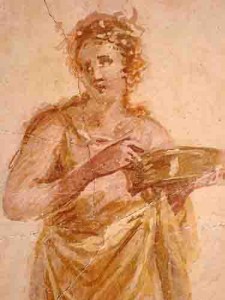Had a new idea the other day about 'a line made by walking'. What if…
Ariadne the Minoan priestess
 Many thanks to the Google people! Google books enables me to find and read a lot of source material. Such as the book ‘The Knossos Labyrinth’ by Rodney Castleden.
Many thanks to the Google people! Google books enables me to find and read a lot of source material. Such as the book ‘The Knossos Labyrinth’ by Rodney Castleden.
Quote page 175: “Ariadne, daughter of King Minos, may have been an historical figure, perhaps a priestess of the goddess Potnia. Her position as a priestess would explain her intimate knowledge of the winding passages of the Labyrinth” “The princess Ariadne, at once Minos’ daughter and Theseus’ lover, is the mystic, mysterious, feminine heart of Minoan civilisation. She is the dark and volatile beauty at the centre of the Labyrinth: princess, priestess, goddess, mistress. She flees from Knossos with Theseus, sailing away at night to meet an ambiguous fate. In some versions of the legend, she is abandoned on another island in the Aegean. In some she marries the god Dionysos, in others she commits suicide”.
I owe the Flickr people thanks, too. Picture on the left taken from mharrsch photostream photographed at the Getty Villa in Malibu, California.
I have come to read into the Ariadne legend a clash between matrilinear and patrilinear culture. Ariadne did not only betray her brother (the Minotaur) in favour of her lover (Theseus), she betrayed the matrilinear way of life – in which the brother is the most important male and has a large role in bringing up children – in favor of the patrilinear way of life – in which the partner is the most important male.
Quote from C.E. Witcombe: “A common feature of patriarchal and patrilineal cultures is “virilocality” (or patrilocality), which means that when a man and woman marry, the wife goes to live at her husband’s family’s residence. A distinguishing feature of matrilineal cultures is “uxorilocality” (or matrilocality), which means that the husband goes to live at his wife’s family’s residence. Evidence of uxorilocality can be found in various myths and legends which are “historically” situated in the Bronze Age.”
| « The Linen Closet | <-- previous post | next post --> | David Hammons: never any fun. » |
|---|







